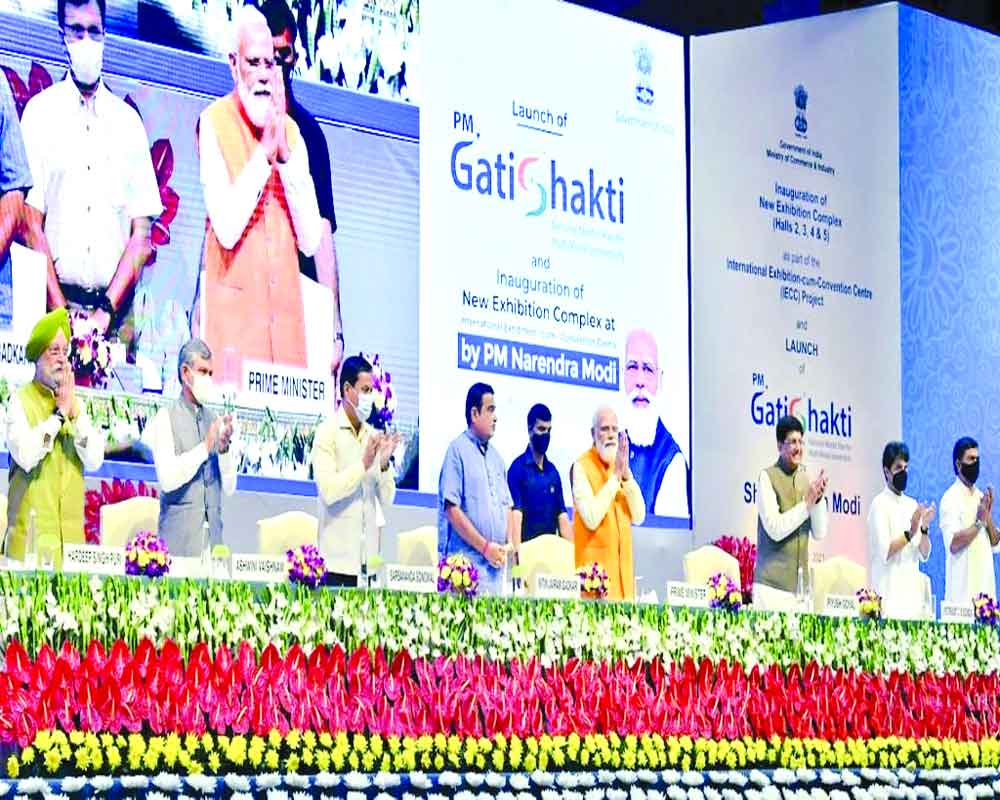The logistics industry is reaping benefits from the rollout of the Pradhan Mantri Gati Shakti & technology adoption
The Indian logistics sector provides livelihood to more than 22 million people, and improving the sector will facilitate 10 per cent lower indirect logistics cost, which will spike 5 to 8 per cent in growth of exports. This will pave the way for a strong Indian economy backed by solid infrastructure.
At present, Indian logistics industry accounts for around 14.4 per cent of the country’s GDP, but its overall cost is around 14 per cent of the GDP, whereas the BRICS average is 11 per cent. Though different studies claim varied logistics cost number, ranging from 8 per cent to 14 per cent of GDP, it is still highly debatable at the current juncture of transition. However, still a significant gap to pull back an economy is there.
In the financial year 2021, when the Indian logistics market was at $250 billion, it has been estimated that the industry would grow at a compound annual growth rate (CAGR) of 10 to 12 per cent and the net worth of the market would be $380 billion in 2025. The economy has rebounded post-pandemic and the Reserve Bank of India (RBI) has projected a GDP growth of 7.2 per cent for the current fiscal ending March 2023.
Logistics is the backbone of any robust economy and should have an unclogged pipeline for seamless flow of information, and uninterrupted supply chain management. Also, it is important for India to reign as the world’s fastest-growing economy over the next few years, driving world growth.
There is a need for a single window clearance for logistics to move in the smoothest way possible.
Only 10 per cent of Indian logistics belongs to the organised sector. It is one of the most highly defragmented industries—and very complex with more than 20 government agencies, 40 PGAs, 37 export promotion councils, and 10,000 commodities. It also involves 12 million employment bases, 200 shipping agencies, 36 logistics services, 129 ICDs, 168 CFSs, 50 IT ecosystems, and banks and insurance agencies. Further, 81 authorities and 500 certificates are required for EXIM. All worked as separate entities, enough to discourage any interested investor.
In India, the logistics sector was an uncared for and a neglected child. It was merely a tool for transporting goods and services. Storage, monitoring, freight clearance, documentation, knowledge about the carrier and containers were never sought for or considered. This led to major mismanagement, delayed sharing of information, and the sector could never achieve its full potential. There was no connection between railways, airways, waterways and roadways, which crippled the sector and marred it with several known and unknown inefficiencies.
Further, the wide geographical diversity of India did not allow concentration of information at one place for a quick perusal and for seamless movement. With a single window, dissemination of information could ease out. If this gets leveraged, both the vendors and consumers of the logistics services would save a lot of time, and stay informed about freight movement, while also controlling several hidden costs.
Prime Minister Narendra Modi has always considered logistics as an essential part of infrastructure development. He mentioned it in his address to the nation during the first phase of lockdown. In fact, it was one of the few sectors which had the permission to operate with limited workforce as the need and purpose was definite.
The PM Gati Shakti-National Master Plan, envisaged with this mindset, was launched last year in October 2021. The plan aims at breaking departmental silos and bringing in more holistic and integrated planning and execution of projects with a view to address the issues of multi-modal and last-mile connectivity. With synchronised and syndicated flow of data, it is hoped that productivity will increase, and there would be better supply-chain management, while also accelerating economic growth.
It holds a promise to give a new direction to the development of modern infrastructure through planning, implementation and monitoring, besides cutting down on time and cost overruns of the projects. It was launched with the sole motive of bringing seven engines of economy, namely, railways, roads, ports, waterways, airports, mass transport and logistics infrastructure on one platform for economic growth and sustainable development.
The touchstone of the Master Plan is to have a world-class modern infrastructure and logistics synergy among different modes of movement—both of people and goods—and location of projects. All the plans under PM Gati Shakti have been proposed to smoothen the logistics knot between the GoI and the state departments.
Post-pandemic, or maybe prior to that, the business model of the industry was changing; it was gradually converging and getting digitised. Unified Logistics Interface Platform (ULIP) is an indigenous API integration platform, developed by leveraging National Industrial Corridor Development Corporation’s (NICDC’s) logistics data bank project, with the aim to create a nationwide single window logistics platform for end-to-end visibility; it is in alignment with the vision of PM Gati Shakti. The virtual gateway has been integrated with 30 systems of seven different ministries through 100+ APIs, covering more than 1,600 fields successfully.
As was proposed by Finance Minister Nirmala Sitharaman in her Budget Speech, it has brought down the logistics cost and time, and has eliminated tedious documentation. It is bringing efficiency and transparency in the logistics industry, thus making India cost competitive and ‘Atmanirbhar’ in the logistics sector.
Leveraged by this virtual gateway, recently, the Logistics Data Bank (LDB) has achieved the milestone of handling 50 million EXIM containers, clearing the roadmap for the New Logistics Policy. This means the sector has complete data of about these 50 million containers, which would reduce a lot of paperwork required for regulatory clearance for further instrumental use of these containers for movement. This would also reduce the lead time for the overall import-export cycle. It would also provide valuable information on empty container management, demand forecasting, lower inventory costs, and bring financial benefits and robust infrastructure.
The Government at this phase can expect more investment in the manufacturing sector as the first stage of confidence building in the logistics sector has been achieved with this milestone.
The LDB handles 100 per cent per cent of India’s EXIM container volume. Conceived as one of the smart community projects between India and Japan during the initial stages of planning of Delhi Mumbai Industrial Corridor project, it has a futuristic outlook.
(The author is Vice-President [Corporate Affairs], National Industrial Corridor Development Corporation)


























